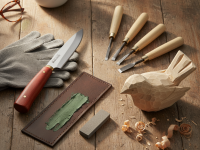Hey there, fellow carving enthusiast! You know that feeling, right? The smooth glide of a perfectly sharp chisel through a block of wood, the satisfying curl of a ribbon of grain peeling away, revealing the beauty beneath. It’s pure bliss. But then there’s the flip side: the frustration of a dull tool dragging, tearing, or even worse, slipping dangerously. I’ve been there, and trust me, it’s not fun.
For years, I treated my carving tools almost as disposable. Use them, toss them in a drawer, grab them agaiext time. My projects suffered, my hands got tired, and I spent far too much time trying to sharpen out nicks that shouldn’t have been there in the first place. It wasn’t until an old master carver, with hands gnarled by years of work but eyes bright with wisdom, took me aside and shared his simple, yet profound, post-use routine that everything clicked. He showed me that taking care of your tools isn’t a chore; it’s an essential part of the carving process, a small investment of time that pays dividends in quality, safety, and longevity.
In this article, I want to share with you what I’ve learned and implemented over the years – a practical, easy-to-follow guide on how to maintain and oil your wood carving tools after each use. Consider this a conversation between carvers, sharing the wisdom gained through countless hours at the bench. Let’s make sure your tools are always ready to bring your artistic visions to life.
Why Bother? The Unsung Heroes of Your Workshop Deserve Better
You might be thinking, “Do I really need to do all that every time?” And my answer, from years of experience, is a resounding YES! Here’s why:
- Better Carving Results: Sharp, well-maintained tools make cleaner cuts, require less force, and allow for finer detail. This means less sanding, less frustration, and more joy in the process. Imagine trying to slice a tomato with a butter knife versus a sharp chef’s knife – it’s the same principle.
- Increased Safety: A dull tool is a dangerous tool. It requires more pressure, which significantly increases the risk of it slipping and causing injury. A sharp tool, handled correctly, is far safer because it bites into the wood exactly where you intend it to.
- Tool Longevity: Proper care prevents rust, corrosion, and damage to the edges and handles. This means your high-quality tools, often a significant investment, will last for decades, becoming trusted companions in your artistic journey.
- Saving Money: Replacing rusted, damaged, or completely worn-out tools is expensive. A little maintenance goes a long way in preventing premature wear and tear.
- Respect for Your Craft: Your tools are an extension of your hands, your creativity. Treating them with respect is treating your craft with respect.
First Steps After the Last Cut: Initial Cleaning
Okay, the shavings are flying, your piece is taking shape, and you’ve decided to call it a day (or at least, for this session). Don’t just toss your tools aside! The very first thing you need to do is clean them. This is crucial because wood dust, sap, and other residues can trap moisture and accelerate corrosion.
Removing Wood Dust and Debris
This part is straightforward. Grab a dedicated brush – I prefer a stiff natural bristle brush or an old toothbrush – and gently brush off all the wood dust, chips, and any loose debris from the blade, shank, and handle. Compressed air (from a can or compressor) can also be your friend here, especially for getting into tight spots on gouges or V-tools. Just be careful not to blow dust into your face or eyes.
For me, this quick brush-down is almost therapeutic, a final act of respect after a session of creating. It helps me transition from the intensity of carving to the calmer routine of maintenance.
Tackling Sticky Sap and Resin
Sometimes, especially when working with resinous woods like pine or cherry, sap can build up on the blades. This isn’t just unsightly; it can make your tools stick and even dull them over time. Here’s how I handle it:
- Rubbing Alcohol (Isopropyl Alcohol): This is my go-to for most sap. Apply a small amount to a clean cloth and gently wipe down the blade. It usually dissolves sap quite effectively.
- Mineral Spirits or Denatured Alcohol: For tougher, dried-on sap, these can be more effective. Always use them in a well-ventilated area and wear gloves, as they can be harsh on your skin.
- Specialized Tool Cleaners: There are products specifically designed for removing resin from saw blades and cutting tools. These can be very effective, but always follow the manufacturer’s instructions.
Whatever cleaner you use, make sure to wipe the blade completely dry afterwards. Any moisture left behind is an invitation for rust.
Inspecting for Damage and Wear: The Detective Work
Once your tools are clean, it’s the perfect time for a quick inspection. Think of yourself as a detective, looking for clues that might indicate future problems. This step helps you identify issues before they become major headaches.
- Check the Edges: Hold the tool up to a light source and examine the cutting edge. Are there any visible nicks, rolls, or burrs? Even tiny imperfections can significantly impact performance. This is where you might decide if a quick strop is needed, or if it’s time for a more thorough sharpening session. While sharpening isn’t the main focus of this article, identifying the need for it is crucial.
- Examine the Handles: Look for any cracks, splits, or looseness where the tang meets the handle. A loose handle is not only aoying but potentially dangerous. Small cracks in wooden handles can often be repaired with wood glue and clamps before they worsen.
- Hunt for Rust Spots: Even tiny specks of rust can spread quickly. If you find any, address them immediately. For minor spots, fine steel wool (0000 grade) or a rust eraser with a bit of oil can often remove them. Deeper rust might require more aggressive methods, but catching it early is always best.
This quick check helps me stay ahead of problems. It’s much easier to fix a small nick with a strop than to grind out a major chip later.
The Heart of the Matter: Oiling Your Tools
This is arguably the most critical step in post-use maintenance. Oiling your tools provides a protective barrier against moisture and oxygen, the two main culprits behind rust and corrosion. It’s like giving your tools a protective shield.
Why Oil?
- Rust Prevention: This is the primary reason. A thin layer of oil physically prevents moisture from reaching the metal surface.
- Lubrication: While not as critical for carving tools as for moving parts, a very slight lubrication helps protect the metal from micro-abrasions during storage or when drawing them from sheaths.
- Preservation: It helps maintain the metal’s integrity and finish over time.
What Kind of Oil Should You Use?
Choosing the right oil is important. Here are my top recommendations:
- Camellia Oil (Tsubaki Oil): This is a traditional Japanese oil, widely used for protecting fine tools like chisels, planes, and samurai swords. It’s natural, non-toxic, doesn’t go rancid, and offers excellent rust protection. It’s my personal favorite and a staple in my workshop.
- Food-Grade Mineral Oil: If you carve items that might come into contact with food (like spoons, bowls, or cutting boards), food-grade mineral oil is a safe and effective choice. It’s readily available and won’t go rancid.
- 3-in-One Oil / General Purpose Machine Oil: These can work in a pinch, but they often leave a sticky residue over time and aren’t designed specifically for tool protection. I tend to avoid them unless I have no other option, and even then, I wipe off as much excess as possible.
- Specialized Tool Oils: Brands like Ballistol (often used for firearms) offer good rust protection and lubrication. They can be excellent choices, but always check their specific properties and if they leave a residue.
What to Avoid: Vegetable oils (like olive oil, canola oil, etc.) will go rancid over time, leaving a gummy, smelly mess on your tools and potentially attracting pests. Just say no!
How to Apply the Oil
Applying oil is simple, but there’s a trick to getting it right:
- A Little Goes a Long Way: You don’t need to drench your tools. Too much oil will just attract dust and dirt, and can become sticky.
- Use a Clean Cloth: Apply a few drops of your chosen oil to a clean, lint-free cloth (an old cotton T-shirt works perfectly).
- Wipe Down the Metal Surfaces: Carefully wipe down all metal parts of the tool, including the blade, the shank, and any exposed metal on the ferrule. Ensure you get into all the nooks and craies of gouges and V-tools.
- Wipe Off Excess: This is crucial. After applying the oil, use a fresh, dry part of the cloth (or a separate clean cloth) to wipe off any excess. You want a very thin, almost invisible film of oil, not a greasy layer. If you can feel it easily on your fingers, there’s too much.
- Don’t Forget the Handles (Optional but Recommended): For wooden handles, a periodic application of linseed oil or even a bit of mineral oil can help nourish the wood and prevent it from drying out and cracking. Just wipe on, let it soak for a few minutes, and wipe off any excess.
This process takes mere seconds per tool, but it’s the bedrock of proper tool care.
Proper Storage: The Final Frontier
You’ve cleaned and oiled your tools – fantastic! Now, where do they live until your next carving session? Proper storage is just as important as cleaning and oiling.
- Individual Protection: Never just toss your tools into a drawer or a box where they can clatter against each other. This is a recipe for dull edges, nicks, and frustration.
- Tool Rolls: My personal favorite. These canvas or leather rolls have individual pockets that keep each tool separate and protected. They’re also great for portability.
- Sheaths/Covers: Leather or custom-made wooden/plastic covers for individual blades are excellent. They protect the edge from accidental bumps and keep moisture away.
- Magnetic Tool Holders: While convenient, ensure the edge isn’t directly contacting other metal parts, and they are stored in a dust-free environment.
- Environment Matters: Store your tools in a dry, stable environment. Avoid damp basements or areas with fluctuating temperatures and humidity, as these conditions are prime for rust formation. If you live in a particularly humid climate, consider adding a desiccant pack (like silica gel) to your tool box or roll.
- Organized and Accessible: While protection is key, also make sure your tools are organized and easy to access. A well-organized workspace makes carving more enjoyable and efficient.
A Routine, Not a Chore: Making it a Habit
The biggest challenge for many is making tool maintenance a consistent habit. I found that by integrating it into my carving “ritual,” it stopped feeling like a chore and became a natural extension of the creative process. After I put down my carving, I grab my brush, my cloth, and my bottle of camellia oil. It takes maybe 5-10 minutes, tops, for a handful of tools. That’s a tiny fraction of the time I spend carving, for a huge payoff.
So, commit to it. After every significant carving session, or at least once a week if you’re carving sporadically, go through these steps. You’ll soon find that it becomes second nature.
Conclusion: Your Tools, Your Legacy
Taking proper care of your wood carving tools isn’t just about preventing rust or keeping them sharp for the next project. It’s about respecting the craft, ensuring your own safety, and ultimately, preserving the means by which you bring beauty into the world. Your tools are not just instruments; they are partners in your artistic journey. Treat them well, and they will serve you faithfully for a lifetime.
So, next time you put down that gouge or chisel, remember the old master’s wisdom. Give your tools the cleaning and oiling they deserve. Your hands, your future carvings, and your wallet will thank you for it. Happy carving!




